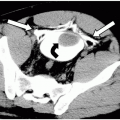Intussusception Reduction
Alexander M. Kowal
Indications.
Enema reduction is the first line of treatment for intussusception in children. Enema reduction, when compared to surgery, is less invasive, decreases morbidity, costs, and length of hospitalization. Enema reduction is less successful when there is a pathologic lead point causing the intussusception, and therefore laparotomy is mandatory in adults. Children who fail enema reduction are reduced surgically.
Enema reduction is contraindicated in patients with dehydration, shock, sepsis, and suspected bowel perforation or necrosis. Therefore, patients with pneumoperitoneum or peritoneal signs on physical examination are reduced surgically. There is a decreased rate of successful reduction after 24 hours of symptoms and surgical reduction is often the choice after 48 hours, particularly if there is bright red blood per rectum. Infants younger than 3 months and children older than 5 years have an increased perforation rate. Small bowel obstruction decreases the success rate but is not a contraindication. The mean perforation rate during reduction is 0.8%. Partial reduction has been shown to reduce incision size at laparotomy.
Delayed attempts at reduction are considered safe and effective in stable patients who have been partially reduced on initial attempts. A 50% success rate has been observed. The optimal time delay between attempts has not yet been defined and varies from 15 minutes to 12 hours. Partial reduction of an initial attempt allows venous congestion and wall edema to subside, allowing for an easier subsequent reduction.
The recurrence rate for intussusception after air enema reduction is 5-15% and after barium reduction is 8-15%, compared to a 5% recurrence rate after surgical reduction. Fifty percent of recurrences present within 48 hours. Repeat enema is safe and effective with recurrent intussusceptions.
Air Versus Contrast.
In the past, the decision to use air versus contrast was largely dependent on the preference of the institution and radiologist. Currently, air reduction has gained favor as a safer, more effective, and less expensive approach. Air reduction has a success rate of 76-90% versus a 55-90% success rate for contrast reduction, possibly due to higher intraluminal pressure with air. Air reduction is also a shorter procedure requiring less fluoroscopy time than contrast reduction. Although air enema is associated with a significantly higher risk of bowel perforation, probably due to higher luminal pressures during the procedure, the perforations are often smaller and cleaner with less fecal spillage and peritoneal contamination. Air reduction may be disadvantageous in patients with marked small bowel gas distention. Perforations secondary to contrast enema have increased morbidity and mortality. Water-soluble contrast is thought to have decreased morbidity in comparison to barium in case of perforation. Barium is avoided due to the risk of chemical peritonitis, infections, and adhesion formation.
All patients should have a surgical consult before attempting enema reduction to ensure that preparations are made for surgery if enema reduction is unsuccessful.
Stay updated, free articles. Join our Telegram channel

Full access? Get Clinical Tree



